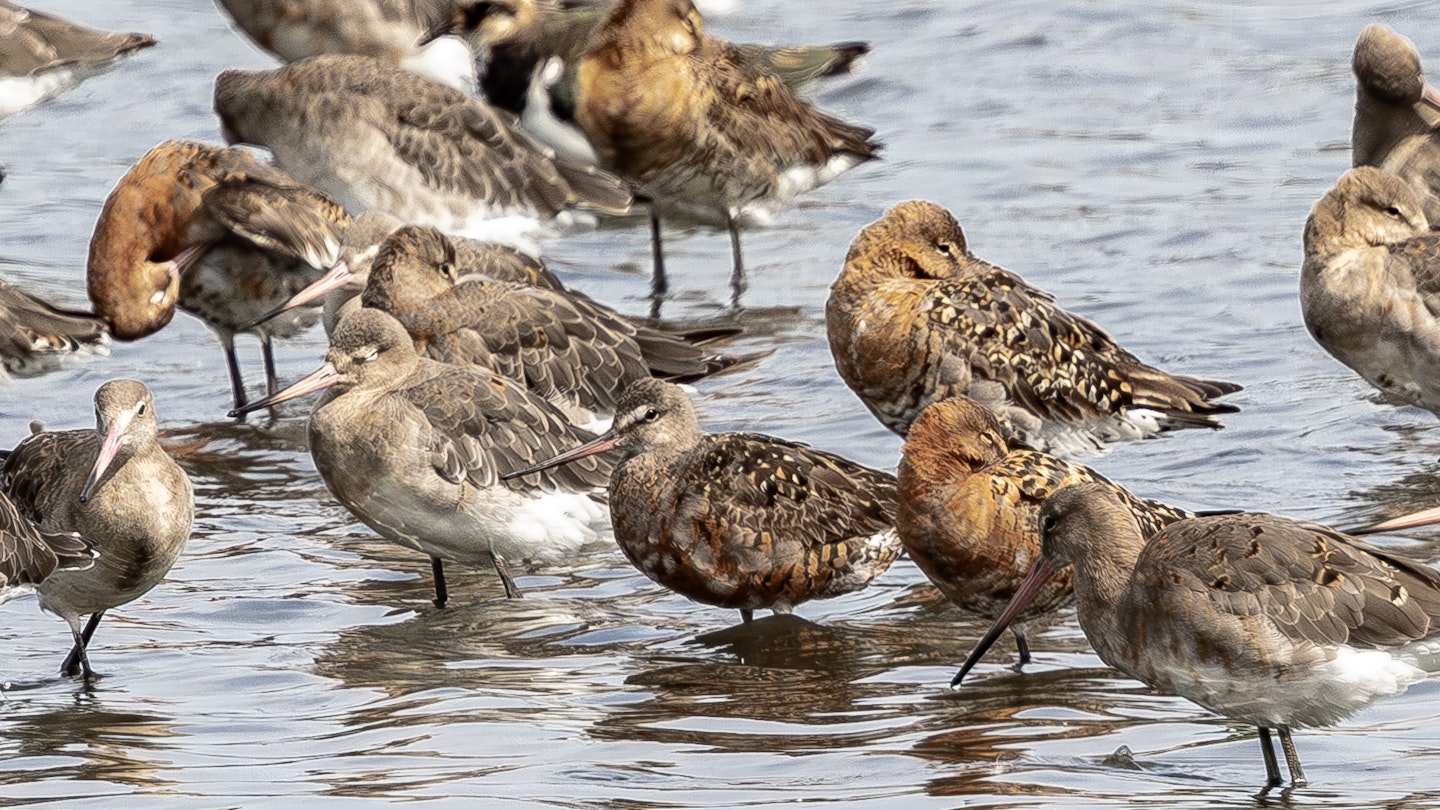A rare transatlantic visitor and a narrow time window made for an exciting day’s birding, writes Ruth Miller

Nowadays we don’t do much twitching, unless it is a local bird, or we are already in the area, but we always keep an eye on UK bird news wherever we are. So, you can imagine our pain when a Hudsonian Godwit turned up on the Wirral close to home, while we were more than 200 miles away, in Somerset. To make matters worse, the bird crossed to the Welsh side of the Dee Estuary; that really rubbed salt in the wound. We followed the news assiduously as the bird appeared and disappeared with the tide. The Dee Estuary is an immense tidal saltmarsh bisected by numerous muddy creeks where a wader can hide, but would it still be around when we got home? Even when we were back, we had a busy schedule of appointments and guiding, so getting to the Dee would be tricky.
Friends helpfully shared details of the bird’s location, as well as frame-filling photos teasing us still more. So, it was no real surprise that two days after getting home we cracked and gave it a go; after all, the bird was fewer than 50 minutes’ drive away. Timing would be crucial. I had an appointment in Llandudno at 2.45pm, high tide at Flint was 2.20pm, and the bird was usually seen in the last half hour before high tide. We had a very narrow window of opportunity, if Lady Luck was on our side.
All went very well initially. We found the location and followed the footpath to the estuary. As we walked through a patch of rough grassland, we were thrilled to see a Barn Owl quartering the area. We admired this handsome caramel-coloured bird slowly skimming over the grass as its attention was focused on seeking prey on the ground below. What a treat to see.
We continued out onto the open marsh. We had forgotten the sheer expanse of this vast estuary as the saltmarsh stretched before us and the towns on the Wirral on the other side shimmered in the distance. Somewhere out there were thousands of Black-tailed Godwits and, among them, one Hudsonian. Luckily, a raised bank offered a better overview, and we joined a birder already scanning with his telescope. From this elevated vantage point, we could see the distant River Dee itself, its nearest edge lined with hundreds of greyish waders. However, everything was still miles away and the telescope only accentuated the jelly wobble effect of the heat haze. How would we pick out one specific bird at this range?
Luckily, the tide comes in extremely rapidly over this pancake-flat landscape, and soon the birds were being pushed towards us by the incoming tide. However, our jubilation at the approaching flock soon turned to dismay as the birds vanished completely into an area of dead ground. Godwits? What Godwits! Cue the arrival of our good friend John, whom we reassured that there were hundreds of godwits, although we hadn’t yet seen the Hudsonian. Now it was a waiting game, as the tide rose. Eventually, the birds should be pushed up on the saltmarsh in front of us, we hoped.
Watching the time, I set my phone alarm so we would know when we had to leave. Time was ticking and while it was nice to catch up on birding gossip with John and enjoy views of a Whimbrel flying by, we were all waiting for that one special bird. Finally, heads and wingtips started to show above the marshland vegetation as the birds shuffled inland ahead of the rising tide. Height was an advantage here, though, and I wasn’t quite tall enough to see when Alan spotted the Hudsonian Godwit briefly among the flock. So frustrating! He talked us all in, so we knew we were looking at the exact spot. “There! The bird just lifted its wings then,” he said, just as I saw dark underwings appear briefly over the vegetation. Could I count wings as a tick?
We wanted more, but had a deadline. Time and tide wait for no birder, but would the incoming tide push the birds into the open before we had to leave? I checked my alarm, we only had 10 more minutes. To paraphrase David Bowie, we were birding under pressure!
The birds’ heads were constantly shifted as the tide encroached on their diminishing mudbank. Surely, they needed to fly up into the open now? Right on cue, the flock lifted and swirled around, a black-and-white maelstrom, before landing on the open ground. Quick, quick! Now was our chance to look for the Hudsonian Godwit among all the others. Slightly smaller and darker than the Black-tailed, we needed it to be in a prominent position to pick it out. The birds settled and many went to sleep; not helpful. Even less helpful was my alarm going off in my pocket.
Thank heavens for the snooze button giving us eight more precious minutes. More and more godwits flew up and joined the throng, presenting even more targets to scan. It was a game of Where’s Wally, but then Alan picked it out again, three birds in from the left just past the big tussock. Funny how, once you had seen the bird, it seemed obvious among the crowd: smaller, darker, and somehow, just different. It wasn’t the best look, but we could see the bird perfectly clearly. My alarm beeped again; it really was time to leave if we were to make it back in time. So, we grabbed a last look at the bird and ran to the car.
After we had left, a Peregrine helpfully flushed the flock and everyone had excellent views of the Hudsonian Godwit in flight showing its diagnostic dark underwings, but hey ho, we had seen the bird and the pressure was off. Until the next time...
